
The society has Corporate members as well as individual members
The CzTA organised the Tunnelling Afternoons (regular seminars focused on various aspects of tunnelling).
CzTA regularly publishes the magazine TUNEL, it is published both in Czech and English languages.
A traditional annual excursion to construction sites abroad was organised in October, this time heading toward Austria.
TheWorking group for conventional tunnelling prepared the actualization of the document Rules and principles of the NATM as the predominate method in the conventional tunnelling.
Blanka Complex of Tunnels
 This largest tunnel construction project in the Czech Republic (the total length of 5.5 km) is part of the City Circle Road (an inner ring) in Prague. During the 2012 were finished works on the final lining, SOS niches, installation of technical equipment and wall cladding were in full swing. In addition, the water table level was successfully returned to the original pre-construction level by completing and closing the grouting system. All significant and large-volume construction activities associated with the structural completion have been largely finished.
This largest tunnel construction project in the Czech Republic (the total length of 5.5 km) is part of the City Circle Road (an inner ring) in Prague. During the 2012 were finished works on the final lining, SOS niches, installation of technical equipment and wall cladding were in full swing. In addition, the water table level was successfully returned to the original pre-construction level by completing and closing the grouting system. All significant and large-volume construction activities associated with the structural completion have been largely finished.
Prague metro line extension VA
The Line A of the Prague metro is to be extended within the framework of this project from the current terminus in Prague 6 – Dejvice up to the Prague airport in Ruzyne. In the future, the length of the new line will reach 13.47 km. For the time being, the construction of the first part started in December 2009. It comprises 6.2 km of the route from the existing station Dejvická via Červený Vrch and Petřiny stations, to Motol station, which is located next to the largest Prague hospital.
On the 26th November 2012 took place the unique breakthrough, the full-face tunnelling machines No. 609 (Tonda) and 610 (Adéla) jointly broke through into the dismantling chamber at Dejvická station.

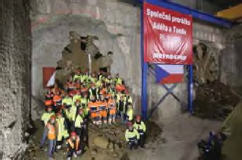
Tunnels on 4th rail transit corridor section between Votice and Benešov
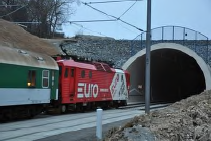 Part of the rail line modernisation project on the section between the towns Votice and Benešov is the construction of 5 double-track tunnels; 4 of them are mined structures. The longest one is the Zahradnice tunnel (1044 m), then the Olbramovice tunnel (480 m), Tomice I (324 m) and Tomice II (252 m) tunnels follow. All of them were driven using the NATM.
Part of the rail line modernisation project on the section between the towns Votice and Benešov is the construction of 5 double-track tunnels; 4 of them are mined structures. The longest one is the Zahradnice tunnel (1044 m), then the Olbramovice tunnel (480 m), Tomice I (324 m) and Tomice II (252 m) tunnels follow. All of them were driven using the NATM.
All of the four mined tunnels have been structurally completed and handed over to the future administrator.
Dobrovského tunnels on the large city circle road Brno(Krávalo pole tunnels)
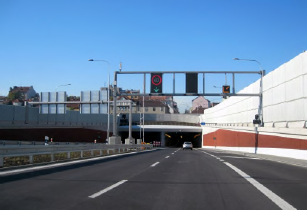 As of 31st August 2012, the Královo Pole tunnels were fully opened to traffic. The two tunnel tubes will significantly contribute to the fluency of vehicular traffic in Brno.
As of 31st August 2012, the Královo Pole tunnels were fully opened to traffic. The two tunnel tubes will significantly contribute to the fluency of vehicular traffic in Brno.
In the end of 2012 was published a book Královopolský tunel Brno (publishing house Doplněk). Authors team headed by Vladislav Horák acquaints the readers with this building of great importance in an original way.
Improving the town protection by diverting flood flows in Jablonec
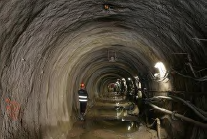 The civils consist of two water distribution structures on the Lužická Nisa and Bílá Nisa River, an intake tunnel, an intake structure, a new discharge tunnel and an outlet structure.
The civils consist of two water distribution structures on the Lužická Nisa and Bílá Nisa River, an intake tunnel, an intake structure, a new discharge tunnel and an outlet structure.
The tunneling has progressed to the final stage. The preparation of the casting of final linings was underway concurrently in all completely excaveted tunnels.
Restoration of Jordan retention reservoir
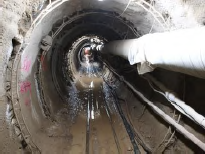 Jordán valley reservoir is the first reservoir in Central Europe developed for supplying a town with water (build in 1492). In 2002 the town of Tábor was affected by flooding and was added to the list of structurally affected regions. It was one of the reasons why in 2004 the Tábor municipality commenced the work on the preparation of the project named "Restoration of Jordán retention reservoir".
Jordán valley reservoir is the first reservoir in Central Europe developed for supplying a town with water (build in 1492). In 2002 the town of Tábor was affected by flooding and was added to the list of structurally affected regions. It was one of the reasons why in 2004 the Tábor municipality commenced the work on the preparation of the project named "Restoration of Jordán retention reservoir".
The purpose of the project as a whole is to provide a bottom outlet of Jordán reservoir in Tábor. The outlet construction comprises cut-and-cover and mined structures, which will eventually divert water from the reservoir to the Tismenice Brook valley. This diversion will be ensured by the following civil engineering structures: intake pressure tunnel with the intake structure, outlet gate structure, pressure-less outlet tunnel with a portal and open channel in the reservoir bottom. The bottom outlet is designed as a linear structure, mostly running underground, which makes the emptying of the reservoir from its deepest point through a by-pass running behind the dam embedment into the right-hand bank possible, with the final discharge to the Tismenice Brook located on the right side of the safety spillway. The work on the bottom outlet had to be coordinated with activities required for the pumping of water from the reservoir.

